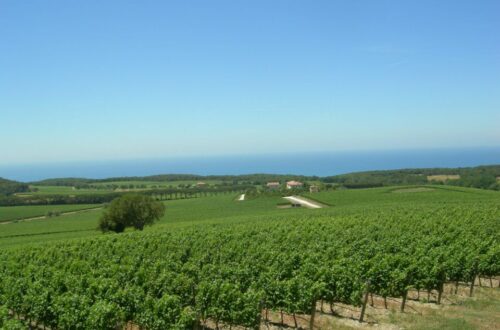Table of Contents
What is Abruzzo DOC Wine?
Abruzzo DOC is one of Italy’s most dynamic designations, established in 2010 to showcase the full spectrum of wines produced across the region. Unlike single-variety appellations, Abruzzo DOC is an umbrella classification that embraces red, white, rosé, sparkling (spumante), and dessert wines. It allows producers flexibility to highlight both international appeal and indigenous Italian grape varieties.
If you’ve ever enjoyed a Montepulciano d’Abruzzo DOC red or a crisp Pecorino white, you’ve already glimpsed the energy and diversity this region brings to Italian wine.
Abruzzo DOC Wine History: From 18th Century Traditions to 2010 Classification
Though formalized as a DOC in 2010, Abruzzo’s wine culture stretches back centuries. Montepulciano vines have thrived here since at least the 18th century, and Trebbiano—often called Italy’s “workhorse white”—has been cultivated since Roman times. The DOC’s creation unified these traditions under a modern regulatory framework, protecting quality while encouraging regional pride.
Today, Abruzzo DOC sits alongside its more famous sibling Montepulciano d’Abruzzo DOC, but with a broader remit, championing both tradition and experimentation.
Where It’s Made: Geography & Terroir of Abruzzo
Vineyards stretch between the Apennine Mountains and the Adriatic Sea, creating a dramatic terroir of high-altitude slopes, rolling hills, and maritime-influenced plains. Soils are predominantly calcareous clay, lending minerality and freshness.
The DOC includes several subzones, each with unique profiles:
- Terre Aquilane – Mountain-influenced wines with freshness and intensity.
- Terre di Chieti – Largest subzone, producing generous reds and vibrant whites.
- Colline Pescaresi – Coastal vineyards with saline freshness.
- Colline Teramane – Prestigious subzone, also home to its own DOCG.
Abruzzo DOC Grape Varieties: Montepulciano, Pecorino & Native Varietals
- Montepulciano: The flagship red grape, delivering rich plum, black cherry, pepper, and herbal notes.
- Trebbiano Abruzzese: A crisp, citrusy white with high acidity.
- Pecorino: Rising star—floral, mineral, and structured; among Abruzzo’s most celebrated exports.
- Passerina, Cococciola, Montonico Bianco, Malvasia: Lesser-known but increasingly revived whites.
Winemaking & DOC Regulations
Abruzzo DOC permits a wide spectrum of wines:
- Bianco: Trebbiano-based blends and varietals.
- Rosso: Montepulciano-led, from young fresh styles to Riserva.
- Spumante: Both Charmat and Metodo Classico sparkling.
- Passito: Lusciously sweet dessert wines.
Rules specify minimum grape percentages, alcohol levels, and aging: e.g., Superiore whites must be at least 90% varietal, while Passito wines age 6+ months before release.
Quick Facts: Abruzzo DOC at a Glance
- Established: 2010
- Region: Central Italy (Abruzzo)
- Styles: Red, white, rosé, sparkling, dessert
- Primary Grapes: Montepulciano, Trebbiano, Pecorino, Passerina
- Climate: Mountain-meets-coast, with Adriatic breezes
- Subzones: Terre Aquilane, Terre di Chieti, Colline Pescaresi, Colline Teramane
- Last DOC Update: July 31, 2024
Best Abruzzo DOC Wines to Try
- Torre dei Beati “Pecorino Giocheremo con i Fiori” – A floral, mineral Pecorino.
- Cataldi Madonna Montepulciano – Deep, structured red with spice.
- Talamonti Trabocco Spumante – Crisp, lemony sparkling wine.
- Masciarelli Trebbiano – Affordable white with bright citrus.
Tasting Notes: Reds, Whites & Sparkling Wines
- Reds: Plum, blackberry, licorice, black pepper, earthy tobacco.
- Whites: Apricot, citrus, wild herbs, saline minerality.
- Spumante: Fresh apple, lemon zest, creamy mousse.
- Passito: Dried fig, honey, candied orange peel.
Serving, Pairing & Storage Guide
- Serving Temperatures: Whites 10–12 °C; reds 16–18 °C.
- Pairings:
- Montepulciano reds → lamb skewers (arrosticini), game, pasta ragù.
- Pecorino whites → seafood, pecorino cheese, roasted vegetables.
- Cerasuolo rosé → spicy antipasti, grilled fish.
- Montepulciano reds → lamb skewers (arrosticini), game, pasta ragù.
- Storage & Aging: Riserva reds can age 5–10 years; Pecorino whites drink well within 3–5 years. Store in a cool, dark cellar.
Abruzzo DOC vs Montepulciano d’Abruzzo & Other Regions
- Abruzzo DOC: Broad umbrella, multiple grapes and styles.
- Montepulciano d’Abruzzo DOC: Focused specifically on Montepulciano reds.
- Compared to Tuscany (Chianti): Abruzzo wines often bolder, fruit-driven, with higher value.
Producers to Know & Vintage Recommendations
- Producers: Masciarelli, Valentini, Emidio Pepe, Talamonti, Cataldi Madonna.
- Vintages: 2015, 2019, and 2020 stand out for reds; 2021 a great year for whites.
Pricing & Where to Buy Abruzzo DOC Wines
- Everyday bottles: $12–20
- Mid-range Riserva or Pecorino varietals: $20–35
- Prestigious producers: $50+
Available at Italian wine retailers, online platforms (Wine.com, Eataly), and specialty importers.
FAQ on Abruzzo DOC Wines
Q: Is Abruzzo DOC the same as Montepulciano d’Abruzzo?
A: No—Montepulciano d’Abruzzo is a focused DOC, while Abruzzo DOC is a broader category.
Q: What is Pecorino wine?
A: A crisp, mineral-driven white grape native to Abruzzo, not related to the cheese.
Q: Are Abruzzo DOC wines good value?
A: Yes—many quality reds and whites fall under $25.
Fun Facts & Cultural Notes
- Abruzzo’s trabocchi fishing huts inspired the name for its sparkling wine category.
- Local dish le virtù, a spring stew of dozens of ingredients, is often paired with regional wines.
- Pecorino grape plantings in Abruzzo now produce over 18 million bottles annually.
Call to Action
🍷 Ready to explore Abruzzo in your glass? Try a Montepulciano Riserva with roasted lamb, or a chilled Pecorino alongside seafood pasta. Share your favorite Abruzzo DOC wine with us using #DrinkItalian, and join our community of culturally curious wine lovers.


